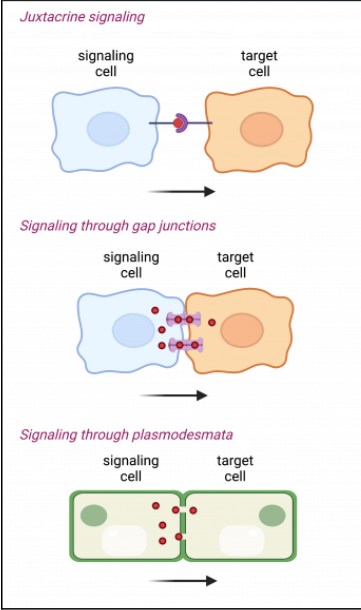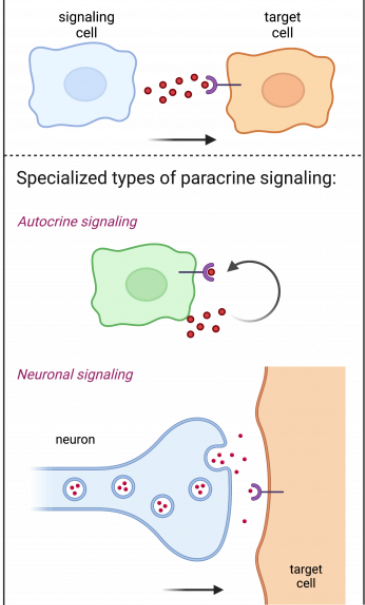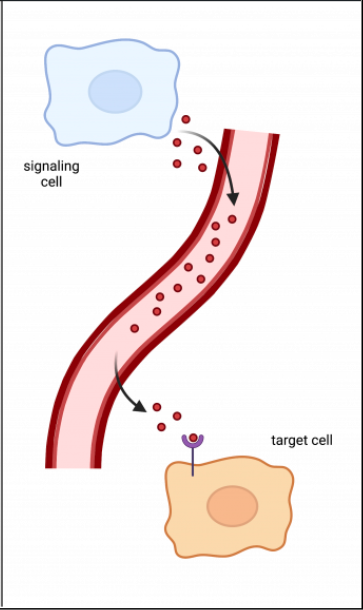unit 4 topics 1 and 2
1/47
There's no tags or description
Looks like no tags are added yet.
Name | Mastery | Learn | Test | Matching | Spaced |
|---|
No study sessions yet.
48 Terms
Cell communication
The process through which cells can detect and respond to signals in their environment. This is crucial for coordinating various functions, including growth, development, and maintaining homeostasis.
Direct contact, local signaling, long-distance signaling
What are the 3 types of signaling for cell communication?
Direct Contact - Gap junction (Animals)
Protein channels that connect adjacent cells. They enable the transfer of ions, small molecules, and electrical impulses directly between cells.
Direct Contact - Plasmodesmata (Plants)
Microscopic channels that traverse the cell walls of plant cells.
Direct Contact - Juxtacrine Signaling
Involves direct contact between immune cells and their target cells. Ex: NK cells bind to infected or cancerous cells through receptor-ligand interactions on their surfaces.
Local signaling - Autocrine signaling
A cell targets itself. Ex: Cancer cells often use this signaling to stimulate their own growth and proliferation
Local signaling - Paracrine signaling
A cell targets a nearby cell. This type of signaling is often seen in tissue repair and immune responses.
Local signaling - Synaptic Signaling
This is a specific type of local signaling used by neurons. Neurotransmitters are released from the synaptic terminal of a neuron and diffuse across the synaptic cleft to bind to receptors on the adjacent neuron, muscle cell, or gland, facilitating rapid communication across synapses.
Long-Distance Signaling - Hormone Signaling in Plants
Plants use hormones to communicate over long distances through their vascular tissues, such as the phloem and xylem.
Long-Distance Signaling - Endocrine Signaling in Animals
In animals, hormones are released into the bloodstream by endocrine glands and travel to target cells throughout the body. Ex: Insulin since it regulates blood sugar levels by signaling cells to need glucose.
Long-Distance Signaling
Direct Signaling

Paracrine Signaling

Endocrine Signaling

Reception, transduction, and response
What are the stages of signal transduction?
Reception
The first stage of cell signaling, where a signaling molecule, known as a ligand, binds to a receptor on the target cell's surface or inside the cell.
Ligands
These are signaling molecules that can be proteins, peptides, amino acids, steroids, or other types of molecules. They bind specifically to receptors.
Receptors
These are proteins that receive the signaling molecules. They can be located on the plasma membrane or within the cell (intracellular receptors).
Plasma membrane receptors
These receptors are embedded in the cell membrane and bind to ligands that cannot cross the membrane. Ex: G protein-coupled receptors (GPCRs) and ion channel receptors.
G-protein coupled receptors
Large family of receptors that work with the help of a G protein. When a ligand binds to a GPCR, it causes a conformational change that activates the G protein, starting the signal transduction pathway.
Ion channels
These receptors act as gates that open or close in response to a ligand, allowing ions to flow into or out of the cell.
Intracellular receptors
These receptors are found inside the cell, in the cytoplasm or nucleus. They bind to ligands that can cross the cell membrane, such as steroid hormones. When the ligand binds, the receptor-ligand complex can directly influence gene expression.
Conformational change
When a ligand binds to its receptor, it causes a change in the receptor's shape. In cascade, setting off a series of events inside the cell.
Transduction
The process by which the signal is converted into a form that can bring about a specific cellular response.
Conversion of signal
The extracellular signal (ligand binding) is converted into an intracellular signal through a series of steps often involving multiple molecules.
Phosphorylation
Adding a phosphate group to a protein, typically using enzymes called kinases. This usually activates the protein.
Dephosphorylation:
Removing a phosphate group, typically using enzymes called phosphatases. This usually deactivates the protein.
Amplification via Second Messengers:
Second messengers are small molecules that propagate the signal inside the cell. Ex: Cyclic AMP (cAMP), which is produced in response to a signal and activates other proteins to amplify the signal.
Response
The final stage, where the transduced signal triggers a specific cellular activity.
Altering Cellular Processes
The signal can lead to various cellular responses such as changes in gene expression, enzyme activity, or cell behavior. Ex:A signal might cause a cell to divide, differentiate, or initiate apoptosis (programmed cell death). It could also lead to the secretion of hormones or other signaling molecules.
Changes in Signaling Pathways
The pathways can be altered by changes in the environment, mutations in the signaling components, or the presence of other signaling molecules.
G Protein-Coupled Receptors (GPCRs)
These receptors interact with G proteins to transmit signals.
G Protein-Coupled Receptors (GPCRs)
The ligand binding causes the GPCR to activate a G protein. GDP becomes GTP. The part of the activated G protein can bind and activate the enzyme.Signal is amplified and can lead to a cellular response.
Ion Channel Receptors
These open or close in response to a ligand binding, allowing ions to move across the cell membrane, which can change the cell’s electrical potential and trigger a response. Located in plasma membrane, important for nervous system.
Homeostasis
The process by which living organisms maintain a stable internal environment despite changes in external conditions.
Set points
sThese are the ideal values or ranges that the body tries to maintain for various physiological conditions, such as temperature, pH, and glucose levels.
Stimulus
Any change in the environment that can trigger a physical or behavioral response. For example, an increase in body temperature due to exercise.
Receptor/Sensor
Detects the stimulus. For instance, temperature sensors in the skin detect changes in external temperature.
Effector
The organ or cell that acts to correct the deviation from the set point. For example, sweat glands act to cool the body.
Response
The action taken by the effector to restore homeostasis. In our example, sweating helps to reduce body temperature.
Feedback loops
Mechanisms that help maintain homeostasis
Negative feedback loops
Work to counteract changes that move conditions away from the set point, thereby maintaining equilibrium.
When a change is detected, the body initiates a response to reverse the change and bring conditions back to the set point.
What happens in a negative feedback loop?
Thermoregulation in humans. When body temperature rises, receptors in the skin and brain detect the increase. The brain signals sweat glands to release sweat, which cools the body down, bringing the temperature back to the set point.
Example of negative feedback loop
Amplify changes, moving the system further from the set point. These are usually associated with processes that need to be pushed to completion.
Positive feedback loops
When a change is detected, the body initiates a response that increases the change.
What happens during a positive feedback loop?
Childbirth. During labor, contractions of the uterus are intensified by the release of oxytocin, which increases the strength and frequency of contractions until the baby is born.
Example of positive feedback loop
Homeostasis imbalance
Occurs when the body is unable to maintain homeostasis, leading to diseases or disorders.